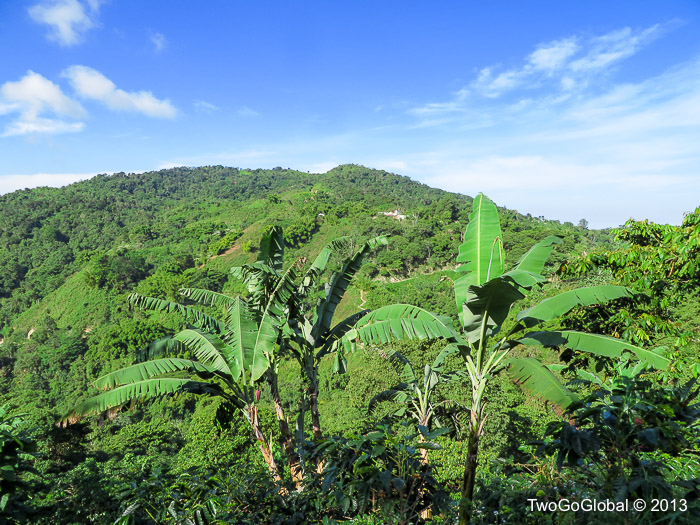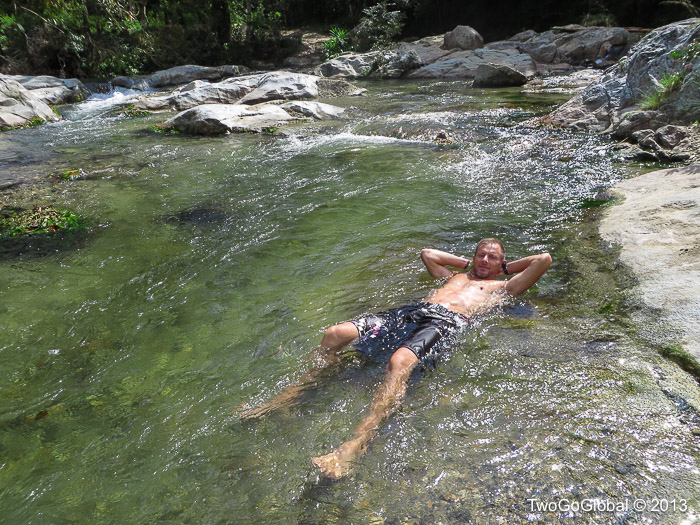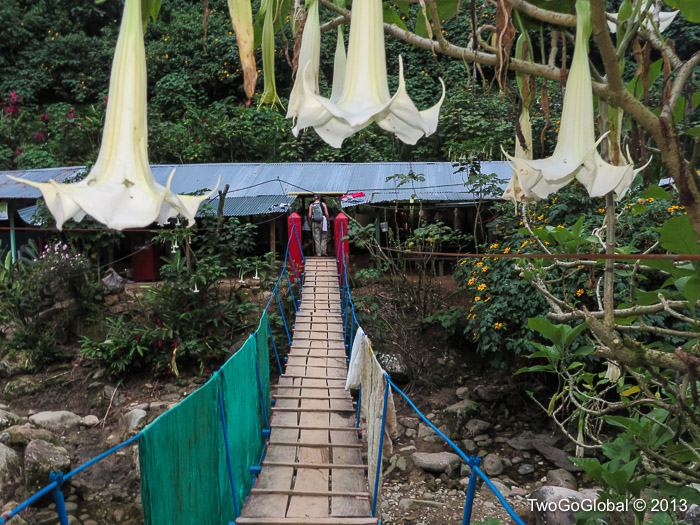The Sierra Nevada de Santa Marta is an isolated mountain range separated from the Andes chain that runs through Colombia. It reachs an altitude of over 5.700 meters (18,700 feet), and just 42 kilometers from the Caribbean coast and is the world’s highest coastal range. We came to this area to visit the Ciudad Perdida or the Lost City, one of Colombia’s top attractions.
Before the Lost City we prematurely left Taganga and headed to Minca at around 600 meters and an hour drive from Santa Marta. We were welcomed at the Emerald Green Guest House by the Irish owner, Niall, and his dog, Ishka – we still find it amazing the far away places where foreigners of all nationalities call home. Niall cooked us some pretty delicious meals and we really enjoyed our time at his place. He’s very knowledgable about the area and provides tours. Unfortunately, Andrea didn’t have any free days since we were there during the week.
Ciudad Perdida, or the Lost City
This was certainly not going to be the Inca Trail to Macchu Picchu trek, but is still one of the number one things to do while in Colombia, without the altitude, and with a good share of humidity and bugs thrown in to make things interesting. Andrea read reports that people were crossing rivers chest high and the trails were completely muddy – she wasn’t sold on doing the trip, but we were going anyway! The trip can be done in 4,5 or 6 days – all being the same price. We chose Magic Tour, with the four day trek costing the same 600,000 COP, or $310 USD. We were disappointed not having an English speaking guide, which for Andrea was far more of a problem, but there were plenty of translators in our group.
Ciudad Perdida is the archaeological site in Sierra Nevada, Colombia, founded about 800 AD, some 650 years earlier than Machu Picchu. A group of local treasure looters found it in 1972 when they saw a series of stone steps rising up the mountainside. They appropiately named it “Green Hell” or “Wide Set”. When gold figurines and ceramic urns from this city began to appear in the local black market, archaeologists headed by the director of the Instituto Colombiano de Antropologia reached the site in 1976 and completed reconstruction between 1976-1982.
The first day was nice and short, and really needed to be as we didn’t get moving until after a nice lunch provided by Magic Tour. With an early stop for a swim followed by some pretty steep sandy hills to deal with, it made for a fun start to the four days. We passed through a couple of other camps before arriving at our designated site, and as with all the accommodations on the trail it was located down by the river, with this one having hammocks to sleep in. This was to be the first time that either of us had ever slept in a hammock for the night, making for a scrappy night’s rest. Night two we had a tent erected in a wooden building alongside bunks, and on our final night we each had a single bunk – if we had stayed longer maybe we would have ended up with a private room and a Tempurpedic mattress!
Parts of the trail had zero shade which made for hot sweaty walking, and pretty much all the trail had relentless sandflies and mosquitoes, with the latter being unbearable if we stayed still for too long. A paled skinned Irish girl we had in the group started out bite free and ended up with her legs covered in red welts, and that was using bug repellent.
After we awoke on the third day we had under an hour to reach the 1200+ steps leading up to and through the city. It was easy walking on a very well made trail, something we would struggle to build even nowadays given the location. The ruins were primarily terraces, staircases and circular stone platforms where huts and other buildings would once have stood – none quite had the wow factor of Macchu Picchu but still an amazing achievement given the age.
The thing we found strange was the military presence, with young, bored looking soldiers hanging around clutching rifles to their chests. We discovered that a number of years ago when paramilitaries and guerillas were present all over Colombia that a group of tourists camping at the ruins were kidnapped for ransom. This did not bode well for tourism so the area was closed off for a while, eventually reopening with protection!
December 17th – December 23rd 2013

























